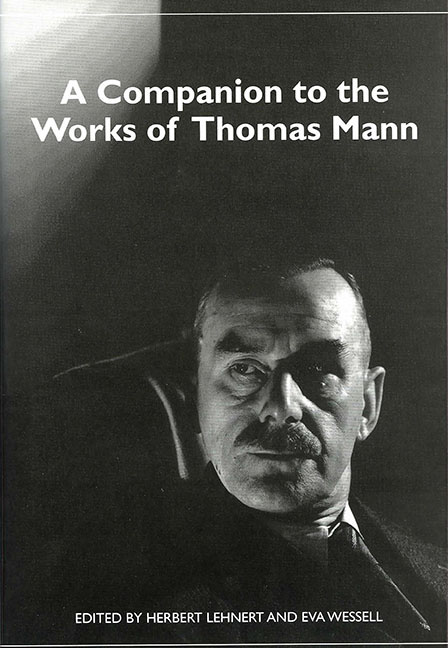Book contents
- Frontmatter
- Contents
- Foreword
- Thomas Mann's Works
- List of Abbreviations
- Introduction
- Thomas Mann's Beginnings and Buddenbrooks
- Art and Society in Thomas Mann's Early Novellas
- Love in Society: Thomas Mann's Early Stories
- “Death in Venice”
- “Mein ‘Friedrich’ — das ist was Anderes”: Thomas Mann's Unwritten Novel about Frederick the Great, King of Prussia
- Magic and Reflections: Thomas Mann's The Magic Mountain and His War Essays
- Thomas Mann's “Autobiographical” Stories
- Joseph and His Brothers
- Lotte in Weimar
- Thomas Mann's Late Politics
- “German” Music and German Catastrophe: A Re-Reading of Doktor Faustus
- The Gaze of Love, Longing, and Desire in Thomas Mann's “The Transposed Heads” and “The Black Swan”
- Felix Krull
- Female Identities and Autobiographical Impulses in Thomas Mann's Work
- Betrayed or Not Betrayed: A Testament?
- Thomas Mann's Comedies
- Notes on the Contributors
- Select Bibliography
- Index
Art and Society in Thomas Mann's Early Novellas
Published online by Cambridge University Press: 28 April 2017
- Frontmatter
- Contents
- Foreword
- Thomas Mann's Works
- List of Abbreviations
- Introduction
- Thomas Mann's Beginnings and Buddenbrooks
- Art and Society in Thomas Mann's Early Novellas
- Love in Society: Thomas Mann's Early Stories
- “Death in Venice”
- “Mein ‘Friedrich’ — das ist was Anderes”: Thomas Mann's Unwritten Novel about Frederick the Great, King of Prussia
- Magic and Reflections: Thomas Mann's The Magic Mountain and His War Essays
- Thomas Mann's “Autobiographical” Stories
- Joseph and His Brothers
- Lotte in Weimar
- Thomas Mann's Late Politics
- “German” Music and German Catastrophe: A Re-Reading of Doktor Faustus
- The Gaze of Love, Longing, and Desire in Thomas Mann's “The Transposed Heads” and “The Black Swan”
- Felix Krull
- Female Identities and Autobiographical Impulses in Thomas Mann's Work
- Betrayed or Not Betrayed: A Testament?
- Thomas Mann's Comedies
- Notes on the Contributors
- Select Bibliography
- Index
Summary
In one of Thomas Mann's early short stories from around the turn of the century, “Das Wunderkind” (1903), an older gentleman compares his own futile attempts at producing a melody on the piano with the perfection of the child prodigy who has just performed:
One must remember that genius [“Genie”] comes from above. God grants his gift. There is nothing one can do about it, and it is not a disgrace being an ordinary human being. It is something like with the Christ child. One may kneel before a child without feeling ashamed. How strangely comforting that is!
What the old gentleman claims as an excuse for his failures at the keyboard is the cult of genius, the belief that genius originates in a divine realm. The implicit argument is that not everyone can be expected to be a genius. His language, colored by a naïvely Christian Sunday-school mentality, borrows from the adoration of the infant Jesus and reveals a semi-religious appreciation of genius that protects and excuses his own failings. The performance of the child prodigy is received in sentimentally religious terms: the performer becomes literally a “Wunderkind” (child of miracles or miracle child) before the old man's eyes.
In another short story, “Gladius Dei” (1902), the protagonist, a religious fanatic in a black coat with a monk's hood, stomps through the streets of Munich. Visiting a church and leaving it again after a short but intense prayer, he stumbles upon an art shop displaying the reproduction of a painting of a voluptuous Madonna with the Christ child. He overhears the cynical conversation of two students describing in explicit sexual terms the effect of the sensuous painting of the Madonna. The students speculate about the artist's model as a woman of easy virtue. Three days later, the fanatic monk-like figure returns to the art shop and demands that the photographic reproduction of the painting be removed from the window and burned, together with all the other works of art displayed, because it offends his religious feelings. Before he is forcefully removed from the premises by a burly janitor who serves as bouncer, the religious fanatic mounts an extensive diatribe against art as desecration of religion.
- Type
- Chapter
- Information
- A Companion to the Works of Thomas Mann , pp. 53 - 72Publisher: Boydell & BrewerPrint publication year: 2004

